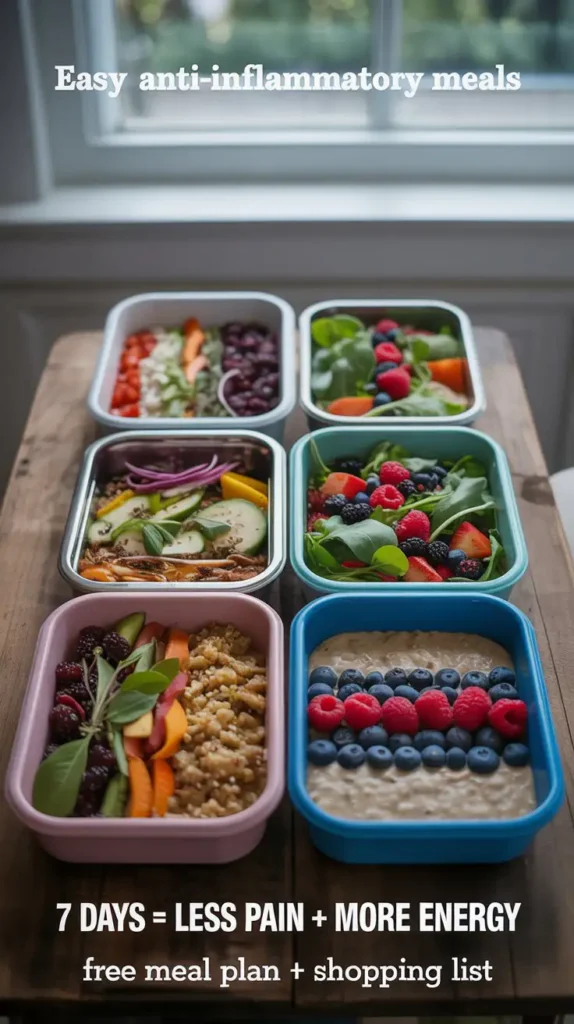An anti-inflammatory diet is a way of eating that helps your body fight swelling and pain. Think of inflammation like a fire in your body. Some foods add fuel to the fire, while others help put it out. This meal plan uses foods that help calm that fire.

Why Try This Meal Plan?
Following an anti-inflammatory diet can help you:
- Feel less achy and sore
- Have more energy during the day
- Sleep better at night
- Keep your heart healthy
- Improve your mood
- Support healthy weight
Foods to Enjoy (Anti-Inflammatory Heroes)
Green Light Foods – Eat Plenty!
Colorful Vegetables:
🌿 Struggling With Chronic Inflammation?
Get the expert-guided Inflammation Ninja course and learn how to reduce inflammation naturally — from home, at your own pace.
- Lifetime access
- Integrative health expert interviews
- Anti-inflammatory meal plan
- Tools to identify root causes
- Leafy greens (spinach, kale, lettuce)
- Broccoli and cauliflower
- Bell peppers (all colors)
- Tomatoes
- Carrots
- Beets
- Sweet potatoes
Healthy Fruits:
- Berries (blueberries, strawberries, raspberries)
- Cherries
- Oranges and grapefruits
- Apples
- Grapes
- Avocados
Good Proteins:
- Fatty fish (salmon, tuna, sardines)
- Chicken breast
- Eggs
- Beans and lentils
- Tofu
Smart Carbs:
- Oats
- Quinoa
- Brown rice
- Whole wheat bread
Healthy Fats:
- Olive oil
- Nuts (almonds, walnuts)
- Seeds (chia, flax, pumpkin)
Flavor Boosters:
- Turmeric
- Ginger
- Garlic
- Green tea
- Dark chocolate (70% or higher)
Foods to Avoid (Inflammation Triggers)
Red Light Foods – Skip These!
- Sugary drinks (soda, sweet tea)
- White bread and pastries
- Fried foods
- Hot dogs and processed meats
- Too much red meat
- Margarine
- Foods with lots of added sugar
Your 7-Day Meal Plan
Day 1: Monday
Focus: Omega-3 Power Day
Today kicks off your anti-inflammatory journey with omega-3 rich foods like salmon and walnuts. You’ll enjoy colorful antioxidant-packed berries and leafy greens that help your body fight inflammation from the inside out.
| Meal | What to Eat | Why It’s Good |
|---|---|---|
| Breakfast | Overnight oats with berries and walnuts | Oats calm inflammation; berries fight free radicals |
| Snack | Apple slices with almond butter | Apples have quercetin; almonds provide vitamin E |
| Lunch | Spinach salad with grilled chicken, cherry tomatoes, olive oil dressing | Leafy greens and tomatoes are inflammation fighters |
| Snack | Carrot sticks with hummus | Chickpeas in hummus reduce inflammation |
| Dinner | Baked salmon with roasted broccoli and quinoa | Salmon has omega-3s; broccoli has sulforaphane |
Day 2: Tuesday
Focus: Gut Health & Fiber Boost
Tuesday emphasizes foods that support your digestive system with probiotics from yogurt and fiber from lentils. You’ll notice steady energy throughout the day thanks to balanced proteins and complex carbs that keep inflammation at bay.
| Meal | What to Eat | Why It’s Good |
|---|---|---|
| Breakfast | Greek yogurt parfait with blueberries and chia seeds | Probiotics support gut health; chia seeds provide omega-3s |
| Snack | Mixed nuts (handful) | Healthy fats reduce inflammation |
| Lunch | Lentil soup with whole grain roll | Lentils are anti-inflammatory powerhouses |
| Snack | Bell pepper strips | Vitamin C fights inflammation |
| Dinner | Grilled chicken with sweet potato and green beans | Lean protein and vitamin A work together |
Day 3: Wednesday
Focus: Protein & Antioxidant Balance
Wednesday brings lean proteins paired with vitamin C-rich foods to maximize nutrient absorption. The combination of eggs, tuna, and turkey provides variety while dark chocolate and berries satisfy your sweet tooth naturally.
| Meal | What to Eat | Why It’s Good |
|---|---|---|
| Breakfast | Scrambled eggs with spinach and whole wheat toast | Eggs provide protein; spinach adds antioxidants |
| Snack | Orange slices | Vitamin C boost |
| Lunch | Tuna salad on mixed greens | Omega-3 rich tuna fights inflammation |
| Snack | Small dark chocolate square with strawberries | Antioxidant combo |
| Dinner | Turkey chili with beans and vegetables | Fiber and protein work as a team |
Day 4: Thursday
Focus: Plant-Powered Nutrition
Thursday highlights the power of plant-based foods with nutrient-dense smoothies and colorful quinoa bowls. You’ll feel light yet satisfied with meals that provide complete proteins and plenty of fiber to reduce inflammation markers.
| Meal | What to Eat | Why It’s Good |
|---|---|---|
| Breakfast | Smoothie with spinach, banana, berries, and flax seeds | Nutrient-packed start |
| Snack | Celery with almond butter | Crunchy anti-inflammatory snack |
| Lunch | Quinoa bowl with roasted vegetables and chickpeas | Complete protein with fiber |
| Snack | Handful of walnuts | Omega-3 fatty acids |
| Dinner | Baked cod with cauliflower rice and asparagus | Light but nutritious dinner |
Day 5: Friday
Focus: Healthy Fats & Fresh Flavors
Friday celebrates healthy fats from avocado and salmon while incorporating fresh vegetables in creative ways. The day’s meals prove that anti-inflammatory eating is delicious with Mediterranean-inspired flavors and satisfying textures.
| Meal | What to Eat | Why It’s Good |
|---|---|---|
| Breakfast | Avocado toast on whole grain bread with tomato | Healthy fats meet lycopene |
| Snack | Grapes | Natural sugars with antioxidants |
| Lunch | Chicken and vegetable stir-fry with brown rice | Colorful veggies provide various antioxidants |
| Snack | Cucumber slices with tzatziki | Cooling and refreshing |
| Dinner | Salmon patties with large mixed salad | Double dose of anti-inflammatory foods |
Day 6: Saturday
Focus: Weekend Variety & Enjoyment
Saturday shows that healthy eating includes treats like whole grain pancakes while staying anti-inflammatory. You’ll enjoy diverse flavors from Mediterranean wraps to zucchini noodles, proving this lifestyle is sustainable and fun.
| Meal | What to Eat | Why It’s Good |
|---|---|---|
| Breakfast | Whole grain pancakes with berry compote | Fiber-rich with antioxidants |
| Snack | Trail mix (nuts and dried fruit) | Energy-boosting mix |
| Lunch | Mediterranean wrap with hummus and veggies | Plant-based goodness |
| Snack | Cherry tomatoes | Lycopene powerhouse |
| Dinner | Grilled shrimp with zucchini noodles and marinara | Low-carb, high-nutrient |
Day 7: Sunday
Focus: Prep & Reset for Success
Sunday combines comfort food favorites like herb-crusted chicken with anti-inflammatory benefits. This day demonstrates how traditional Sunday meals can be both nourishing and inflammation-fighting, setting you up for another successful week ahead.
| Meal | What to Eat | Why It’s Good |
|---|---|---|
| Breakfast | Veggie omelet with whole grain toast | Protein and veggie combo |
| Snack | Pear slices with cinnamon | Natural sweetness with spice benefits |
| Lunch | Bean and vegetable soup | Fiber and protein together |
| Snack | Edamame | Plant protein snack |
| Dinner | Herb-crusted chicken with roasted root vegetables | Herbs add extra anti-inflammatory power |
Shopping List for the Week
Proteins
- 2 pounds salmon
- 2 pounds chicken breast
- 1 pound ground turkey
- 1 pound cod
- 1 pound shrimp
- 2 cans tuna
- 2 dozen eggs
- Greek yogurt (32 oz)
- Tofu (1 package)
Vegetables
- 3 bags spinach
- 2 heads broccoli
- 1 head cauliflower
- 2 bell peppers (mixed colors)
- 2 pounds carrots
- 2 sweet potatoes
- 1 pound green beans
- 2 zucchini
- 1 pound asparagus
- Mixed salad greens
- Cherry tomatoes (2 pints)
- Celery
- Cucumber
Fruits
- 2 cups blueberries
- 1 cup strawberries
- 1 cup raspberries
- 3 apples
- 2 oranges
- 1 bunch grapes
- 2 avocados
- 2 bananas
- 2 pears
Grains & Legumes
- Oats (1 container)
- Quinoa (1 bag)
- Brown rice (1 bag)
- Whole grain bread (1 loaf)
- Whole wheat pasta
- 2 cans black beans
- 2 cans chickpeas
- 1 bag dried lentils
Nuts, Seeds & Oils
- Almonds
- Walnuts
- Mixed nuts
- Chia seeds
- Flax seeds
- Olive oil
- Almond butter
Herbs & Spices
- Turmeric
- Ginger (fresh)
- Garlic
- Cinnamon
- Black pepper
- Dried herbs (basil, oregano, thyme)
Meal Prep Tips for Success
Sunday Prep Day
- Cook grains: Make a big batch of quinoa and brown rice
- Chop vegetables: Wash and cut veggies for the week
- Prepare proteins: Grill chicken breasts, cook hard-boiled eggs
- Make overnight oats: Prep 3 jars for easy breakfasts
- Portion snacks: Divide nuts into small containers
Time-Saving Tricks
- Use frozen vegetables when fresh aren’t available
- Buy pre-washed salad greens
- Cook double portions for dinner to have leftovers for lunch
- Keep canned beans on hand for quick protein
- Batch cook soups and freeze portions
Important Reminders
Stay Hydrated
- Drink 8 glasses of water daily
- Try green tea between meals
- Add lemon to water for extra vitamin C
- Limit coffee to 2 cups per day
Portion Control Guide
- Protein: Size of your palm
- Vegetables: Size of your fist (eat 2-3 fists per meal)
- Grains: Size of your cupped hand
- Fats: Size of your thumb
Listen to Your Body
- Eat when hungry, stop when satisfied
- Notice how different foods make you feel
- Keep a food diary if helpful
- Adjust portions based on your activity level
Common Questions and Answers
Q: Can I have dessert on this plan? A: Yes! Try dark chocolate, fresh fruit, or yogurt with berries.
Q: What if I’m vegetarian? A: Replace fish and meat with beans, lentils, tofu, and tempeh.
Q: Can I eat out while following this plan? A: Yes! Choose grilled proteins, ask for extra vegetables, and request olive oil for dressing.
Q: How long should I follow this diet? A: This is a healthy eating pattern you can follow long-term. Most people notice benefits after 2-3 weeks.
Q: Can kids follow this meal plan? A: Yes! These are healthy foods for the whole family. Adjust portions for children.
Quick Recipe Ideas
5-Minute Anti-Inflammatory Smoothie
- 1 cup spinach
- 1/2 cup blueberries
- 1 banana
- 1 tablespoon flax seeds
- 1 cup unsweetened almond milk
- Blend and enjoy!
Easy Turmeric Chicken
- Season chicken with turmeric, garlic, and black pepper
- Bake at 375°F for 25 minutes
- Serve with steamed vegetables
Simple Salmon Dinner
- Brush salmon with olive oil
- Sprinkle with lemon and dill
- Bake at 400°F for 12-15 minutes
- Pair with quinoa and broccoli
Final Tips for Success
- Start slowly – Don’t change everything at once
- Plan ahead – Meal prep on weekends saves time
- Keep it colorful – Eat rainbow-colored foods
- Stay consistent – Small daily choices add up
- Be patient – Your body needs time to adjust
- Track progress – Note energy levels and how you feel
- Get support – Share this plan with family and friends
Conclusion
Eating in a way that calms inflammation doesn’t have to be complicated—it just comes down to building meals around real, nourishing foods and steering clear of the things that work against your body. Start with small swaps, try out new flavors, and notice how your energy, digestion, and mood respond.
Over time, these choices add up to lasting changes you can actually feel. Keep this plan handy, revisit it when you’re stuck for ideas, and let it guide you toward a way of eating that feels good and actually fits your life.

Sandra Hernandez, a resident of New York, is an active contributor on lifebing.com. Her passion for knowledge fuels her writing journey as she delves into fascinating topics that capture her curiosity.
